
QR codes seem like a pretty simple technology. All users only need to pull out their smartphones and scan the QR code to access any information.
However, on the other end, the owners of the code—companies, marketing experts, or non-profit organizations—can access a myriad of metrics to analyze critical metrics to improve campaign effectiveness.
This is only possible through a not-so-secret feature: QR code tracking.
In this post, you’ll learn what QR code tracking is, why it is so useful to improve your marketing campaigns, and how to create multiple QR codes that offer unique insights.
You’ll also learn how to customize these codes to increase user engagement, giving your marketing campaigns the lift they need to achieve your goals.
Table of Contents
- What Is a QR Code?
- Dynamic QR Codes vs Static QR Codes
- What Is QR Code Tracking?
- What to Use QR Code Tracking for?
- Benefits of Using QR Code Tracking
- Use Cases of QR Code Tracking
- Create Dynamic QR Codes with Tracking Features on Our QR Code Generator
- Wrap-Up
What Is a QR Code?

A QR code, or Quick Response code, is a two-dimensional matrix barcode that contains information that can be easily scanned and read by various devices —smartphones, tablets, or dedicated QR code scanners.
QR codes are typically square-shaped and consist of black square dots arranged on a white background, creating a grid-like pattern.
However, on QR.io, you can create customized QR codes with logos and images, and change both the color and the pattern to make them unique.
QR codes are designed to store various data types, including text, URLs, contact information, or other digital content. Users need to point their smartphone or any of the several QR code readers to access the information on their devices.
Also see: What Is a QR Code and How You Can Create One
Dynamic QR Codes vs Static QR Codes
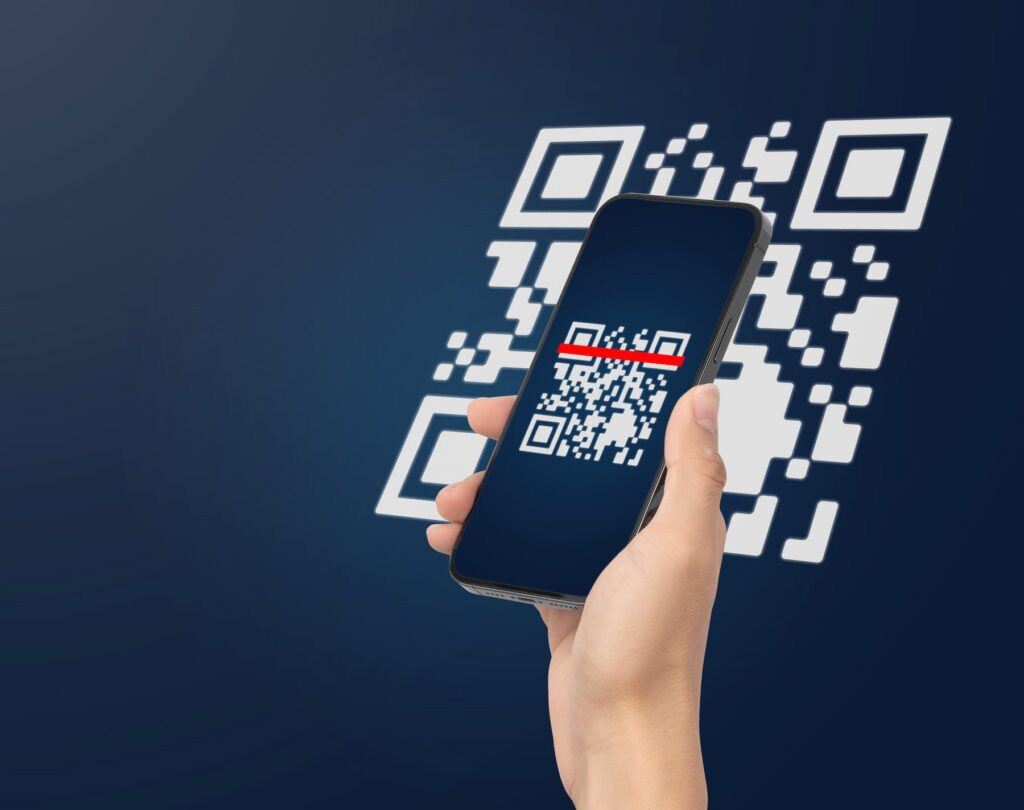
Dynamic and static QR codes are two different kinds of QR codes that serve distinct purposes.
Static QR codes contain fixed, unchangeable data. Once generated, the information stored in a static QR code remains the same for its entire lifespan.
These QR codes are commonly used for straightforward applications, such as sharing a website URL, contact information, or basic details that don’t need to be updated frequently. Static QR codes are ideal when the content linked to the QR code is stable and unlikely to change.
Dynamic QR codes, on the other hand, contain data that can be edited or updated even after they have been created and distributed. The data is not directly encoded into the QR code itself; instead, it is stored on a server or in a database.
These codes are versatile and practical for applications where the linked content may change over time. This makes them more adaptable for marketing campaigns.
With dynamic QR codes, you can update the linked information without the need to generate a new QR code. This allows for flexibility in managing the content associated with the code.
The dynamic QR code is the one that sports the unique tracking feature.
Also see: Static Vs Dynamic QR Codes: When to Use Either?
What Is QR Code Tracking?
QR code tracking —also known as QR code analytics— is the process of monitoring and collecting data about the interactions with QR codes. It involves gathering information on when, where, and how QR codes are scanned.
Trackable QR codes are valuable for businesses and organizations in various industries to assess the effectiveness of any QR code campaign and make data-driven decisions. On QR.io, you can create any type of QR code —email, URL, YouTube video, etc.— that offers useful QR code metrics.
If Google Analytics helps you track engagement metrics on your site, the tracking abilities of dynamic QR codes allow you to do the same for your QR code campaigns.
Key aspects of QR code tracking include:
- Scan Data: QR code tracking records the date and time of QR code scans.
- Geographical Data: It shows where QR codes are scanned and the location of the scanning activity. This information can be useful for targeted marketing efforts.
- Device Insights: QR code tracking may include information about the types of devices used for scanning (e.g., smartphones, tablets) and their operating systems.
What to Use QR Code Tracking for?
There are many advantageous reasons why you should use dynamic QR codes with tracking abilities. they all relate to one objective: being able to track the QR code’s performance.
Assessing the performance of marketing campaigns

By tracking QR codes, businesses can determine how successful their QR code marketing efforts are, whether they are for product promotions, events, or advertising. By tracking QR code scans, marketers can measure the effectiveness of their campaigns, monitor engagement, and assess which channels are most successful in driving user interaction.
Measuring user engagement
By analyzing user interactions with the linked content, organizations can gain insights into customer behavior and preferences.
Utilize QR code tracking to monitor the number, time, and location of scans. Analyze the data to understand user behavior, peak engagement times, and popular geographical areas.
You can also set conversion goals. Define specific conversion goals related to user engagement. This could be completing a survey, making a purchase, signing up for a newsletter, or any other action that indicates a high level of engagement.
Identifying high-traffic locations
For QR codes placed in physical locations, tracking data can reveal which locations generate the most scans. This information is so incredibly valuable to readjust your marketing efforts and look for places with higher traffic to increase engagement.
A/B testing and optimization
QR code tracking allows businesses to experiment with different QR code designs or linked content and evaluate which performs better. A/B testing with QR code tracking involves comparing two or more variations of QR codes to determine which performs better in terms of user engagement, conversion rates, or other relevant QR code tracking metrics.
Variations can include changes in design, color, call-to-action message, or even the content linked to the QR code. Also, ensure that each variation is unique and serves the specific purpose of the A/B test. You can also recruit a webflow development agency to craft and optimize these variations for maximum impact.
Security and fraud prevention

Tracking can help detect unauthorized scans or suspicious activity, enhancing the security of QR code implementations.
Benefits of Using QR Code Tracking
QR code tracking offers several benefits and advantages for businesses and organizations across various industries. Here are some of the key advantages of using QR code tracking:
Performance measurement
QR code tracking allows you to measure the success of your QR code campaigns. You can track the number of scans, user interactions, and conversion rates, providing valuable insights into the effectiveness of your marketing efforts.
Data analytics
By collecting data on QR code scans and user behavior, you can gain valuable analytics about your target audience. This data can be used to refine marketing strategies, improve content, and make data-driven decisions.

Real-time insights
Many QR code tracking solutions provide real-time data, enabling you to monitor campaign performance as it unfolds. This allows for quick adjustments and optimizations based on current trends and user engagement.
User engagement analysis
You can track how users interact with the content linked to the QR code, including how long they stay on a webpage, which links they click, and whether they complete desired actions, such as filling out a form or making a purchase.
Location-based targeting
QR code tracking can provide information about where and when QR codes are scanned. This data can be valuable for location-based marketing and targeted advertising efforts.
Content optimization
The insights gained from QR code tracking can help you optimize the content linked to QR codes. By understanding user preferences and behaviors, you can create more engaging and relevant content.
A/B testing
QR code tracking enables you to perform A/B testing, where you can experiment with different QR code designs, calls to action, or linked content to determine which performs better and yields higher conversion rates.
Cost-effective marketing

By tracking the performance of QR code campaigns, you can allocate resources more effectively, eliminating ineffective strategies and focusing on those that provide the best return on investment.
Enhanced user experience
By analyzing user interactions, you can tailor the user experience to better meet the needs and expectations of your audience. This can result in higher customer satisfaction and loyalty.
Security and fraud detection
QR code tracking can help detect unauthorized scans or suspicious activity, enhancing the security of QR code implementations and protecting against fraudulent activities.
Inventory and asset management
For businesses using QR codes for inventory or asset tracking, QR code tracking data provides real-time visibility into the status and location of items.
Paired with the benefits of WMS (Warehouse Management System), the higher level of insight enables optimized inventory control, reduced operational costs, and improved decision-making processes based on up-to-date information.
Compliance and reporting
QR code tracking can assist in compliance reporting, especially in industries where tracking is necessary for regulatory purposes.
Use Cases of QR Code Tracking
QR code tracking has a myriad of applications, often for great benefits. Let’s review some interesting use cases.
Marketing and Advertising
Campaign tracking
QR code tracking is a valuable tool for marketing campaign tracking, enabling businesses to monitor the performance of their QR code-based marketing initiatives and make data-driven decisions.
Use QR.io’s tracking platform to monitor QR code scans in real time. Track the number of scans, scan locations, and devices used. Pay attention to trends and peak activity periods.
Customer engagement
With QR code tracking, you can tailor content to individual customer preferences and behaviors. You can provide more personalized and relevant content by understanding what users are interested in.
QR code tracking empowers businesses to understand and improve customer engagement by offering convenience, personalization, and immediate access to relevant content. It provides a data-driven approach to engage with customers more effectively and build stronger relationships.
Event Management
Ticketing and registration
QR code tracking is a highly effective and efficient event registration tool for various reasons. When used for event registration, QR code tracking offers several benefits that enhance the overall experience for both event organizers and attendees.
Event organizers can track and monitor attendance in real time using QR code tracking. This provides valuable insights into the number of attendees, session popularity, and any capacity constraints.
Attendance tracking
QR code tracking streamlines the check-in process, making it faster and more efficient. Attendees simply need to scan their codes, and their attendance is recorded almost instantly. This reduces wait times and congestion at entry points.
Create Dynamic QR Codes with Tracking Features on Our QR Code Generator
With QR.io, you can create dynamic QR codes with unique tracking abilities and Google Analytics integration. Whether for your marketing campaigns, events, or any other purposes, our codes will give you valuable insights.
Step 1. Open a QR.io account
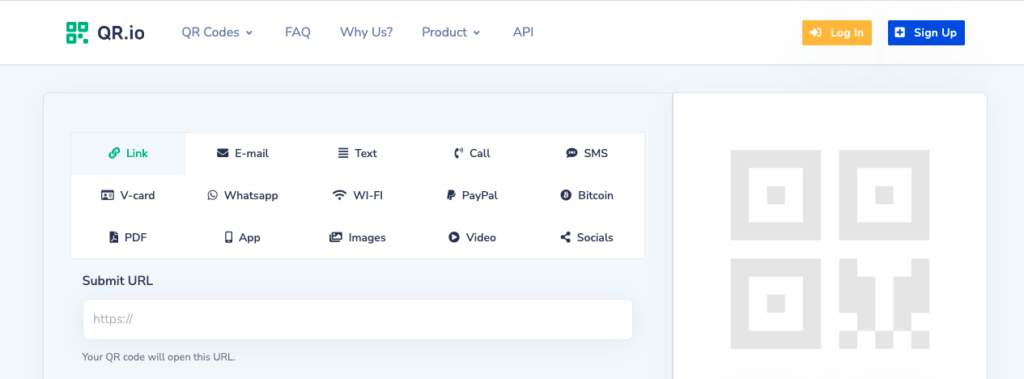
Step 2. Go to your new dashboard
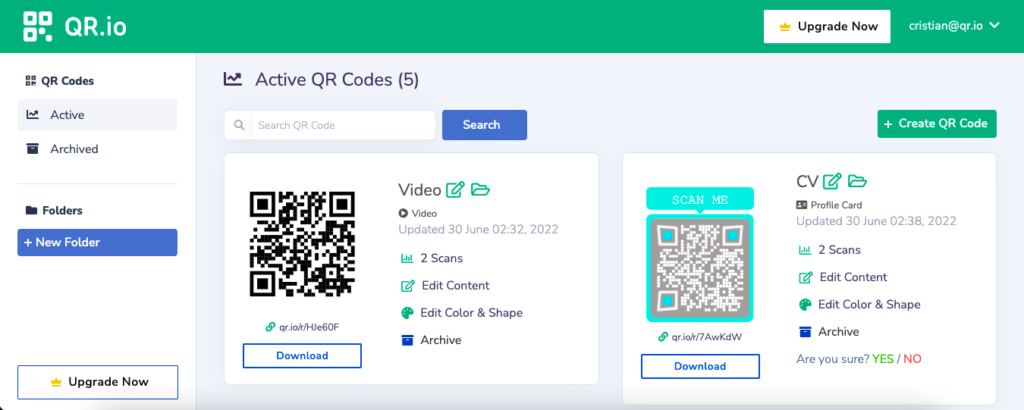
Step 3. Click +Create, choose Dynamic, and select type
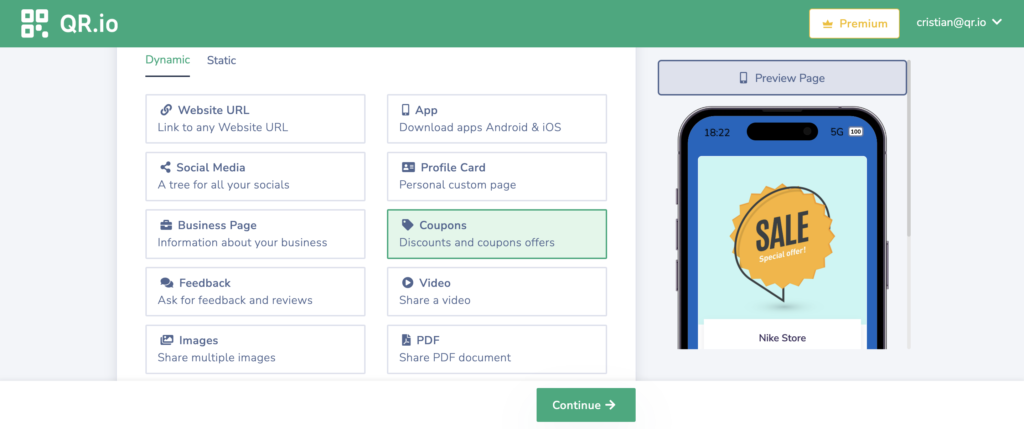
Step 4. Customize and enter the information
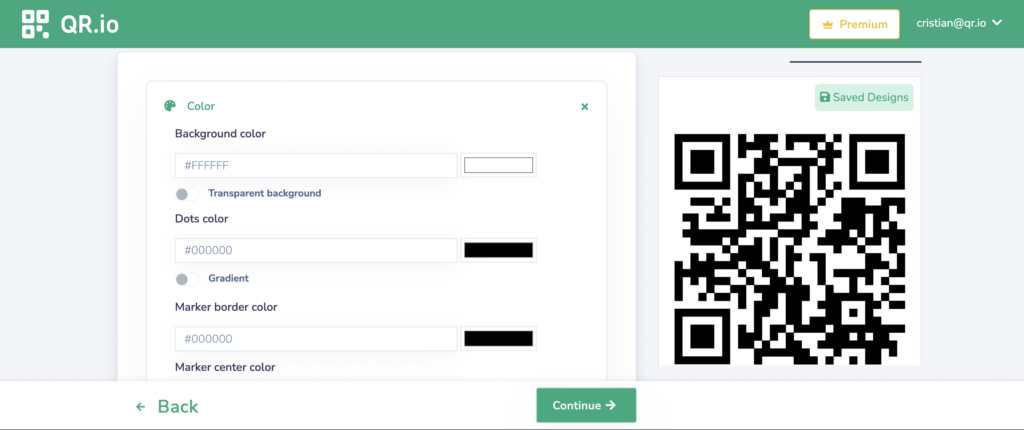
Step 5. Download, print, and enjoy!

Wrap-Up
A trackable QR code is a killer addition to your marketing campaigns —offline and online. You can track QR codes regardless of the type and their content! Give your marketing a huge boost and gather all the necessary information to succeed!
